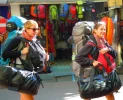- Time of past OR future Camino
- Frances 15,16,18
VdlP 23, Invierno 23, Fisterra 23
Yes, that ever popular topic of pack weight!
I'm sorry if the 'old hands' here understand all this 'inside out' but I'm a bit of a confused 'Newbie' ...
So I thought a Poll might be fun, and hopefully informative too.
This is not a Poll about precisely what you pack. But about what types or categories of things you include when weighing your pack.
Do you include food, water (how much), trekking poles, your phone, your camera ....
I'm struggling to get my pack weight down, and I think it might in some small part be due to the fact that I am including things in my pack weight that perhaps others might not be.
I'm taking the view that anything I am not actually wearing, gets included in my pack weight. So the only things not included are the boots, socks, underwear, pants and shirt that I would be wearing. i.e. anything I might need for additional weather protection, goes in the pack weight.
If you don't even carry trekking poles for example, just leave that blank.
Obvious things that most people would carry, we can leave out. Toiletries, spare clothes etc. As well as things that most people would NOT carry. Like a stove or tent.
This is more to get an 'Apples v Apples' comparison or 'standard' for what people include when weighing a pack.
What do you include? (We can also assume the weight of the pack itself is included)
I'm sorry if the 'old hands' here understand all this 'inside out' but I'm a bit of a confused 'Newbie' ...
So I thought a Poll might be fun, and hopefully informative too.
This is not a Poll about precisely what you pack. But about what types or categories of things you include when weighing your pack.
Do you include food, water (how much), trekking poles, your phone, your camera ....
I'm struggling to get my pack weight down, and I think it might in some small part be due to the fact that I am including things in my pack weight that perhaps others might not be.
I'm taking the view that anything I am not actually wearing, gets included in my pack weight. So the only things not included are the boots, socks, underwear, pants and shirt that I would be wearing. i.e. anything I might need for additional weather protection, goes in the pack weight.
If you don't even carry trekking poles for example, just leave that blank.
Obvious things that most people would carry, we can leave out. Toiletries, spare clothes etc. As well as things that most people would NOT carry. Like a stove or tent.
This is more to get an 'Apples v Apples' comparison or 'standard' for what people include when weighing a pack.
What do you include? (We can also assume the weight of the pack itself is included)






















